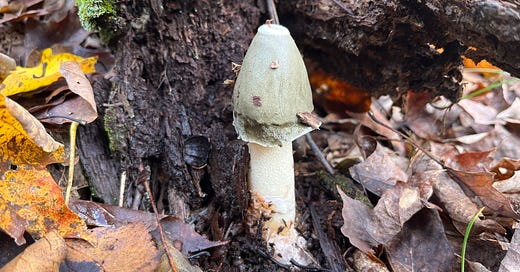Good evening, friends,
This week’s mushroom is the conspicuous Ravenel’s Stinkhorn (Phallus ravenelii) found yesterday in Harriman State Park. Phil, my friend and former coworker from Central Park, was in town for the weekend and we met up with another Central Park vet, Brett, to look for mushrooms and whatever else was in the woods. Always nice to get the “tea” (the youths’ term for gossip) on what’s going on within those perimeter walls. We stumbled upon a bunch of mushrooms, including today’s stinkhorn, that we’ll hopefully look at in the upcoming weeks. And speaking of Central Park, we’re going to do a walk there this weekend, more info on that at the bottom.
Fun Facts
Obviously the genus name is Phallus because of the penile shape, let’s get the giggles out of the way now. Okay, cut it out. The species Ravenelii is named after the South Carolina-born mycologist and botanist Henry Ravenel (1814-1887). Ravenel kept scrupulous journals which contributed immensely to the scientific understanding of mycology and botany in eastern North America. He was also a huge Confederacy guy. I suppose you take the productive contributions to mycology with the not-so-productive contributions to destabilizing the nation. The duality of man.
The stinkhorns develop from egg-like sacks. The stinkhorn “eggs” are edible, and knowing this I brought a couple home to do some boots-on-the-ground journalism. I wanted to find out if the taste was as bad as the smell. The first thing I noticed is the eggs didn’t smell, that was a relief. It turns out it’s the green spore mass (seen above) that emits a putrid odor. I got some cooking ideas from Adam Haritan on the Youtube - I sautéed one egg and boiled the other.
The first thing I noticed, before even cooking, is that the eggs had turned from the white they were on the wood to a light pink. I sautéed one egg in cast iron with just a little salt and pep and boiled the other. I cooked each for seven minutes (got that from the youtube). Both tasted strongly like radishes but, surprisingly, I was much more into the texture of the boiled stinkhorn rather than the sautéed preparation. The boiled version was a little smoother, like a deviled egg, while the sautéed stinkhorn was more gelatinous, like cartilage. I would eat the boiled version again and understand why stinkhorn eggs are traditionally served in soups.


Ecology
The fungus is saprobic and decomposes lignin-rich organic material. Lignin is one of the main components of plant cell walls and a favorite food of white rot fungi. The mushroom is only found in North America east of the Rockies and are a classic fall mushroom - the vast majority of iNaturalist observations occur in September and October. While the range is restricted to eastern NA, they’re comfortable in a variety of habitats and can be found growing anywhere from landscaped garden beds to decomposed logs in state parks.

The green area at the tip of the mushroom is the gleba (the spore mass). The gleba emits a rancid odor to attract flies. I’d describe the smell as a “noxious chlorine” - like if the whiffs you catch off a chlorinated pool were suffocatingly strong. The flies land on the top of the mushroom where they unknowingly (or, perhaps, knowingly) pick up spores and spread them at their next destination. Similar to plants that use pollinators for reproduction. The mushrooms can grow solitarily or in clusters, and there were roughly seven other stinkhorns in this instance.
Another species you’ll find in the northeast, the common stinkhorn (Phallus impudicus) has a similar shape and color but the head is ridged and pitted (like a morel). Our stinkhorn is smooth. I’ve also written about a couple other stinkhorns, the stinky squid and the devil’s dipstick, if you can’t get enough of these foetid, phallic peculiarities.
Central Park Walk
The walk is going to be at 10AM on Saturday, 10/28. Last week I put Sunday, but I had my dates mixed up. Hand up, that’s on me. Anyway, the walk this past Saturday was a lot of fun and I’m excited to see what’s popping up in the park now. We’ll also see how well my friend/former coworker Erickson is taking care of the Ramble now that he’s the keeper of bankrock. We’ll meet at the toolboxes (location below) and I just might have some dried maitake to send folks home with.
Full moon on Saturday,
Aubrey
References:
Kuo, M. (2021, January). Phallus ravenelii. Retrieved from the MushroomExpert.Com Web site: http://www.mushroomexpert.com/phallus_ravenelii.html
https://www.messiah.edu/Oakes/fungi_on_wood/stinkhorn/species%20pages/Phallus%20ravenelii.htm
https://www.scencyclopedia.org/sce/entries/ravenel-henry-william/
https://mdc.mo.gov/discover-nature/field-guide/ravenels-stinkhorn









